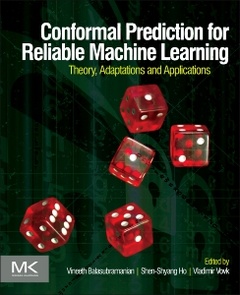Description
Conformal Prediction for Reliable Machine Learning
Theory, Adaptations and Applications
Coordinators: Balasubramanian Vineeth, Ho Shen-Shyang, Vovk Vladimir
Language: English
Subject for Conformal Prediction for Reliable Machine Learning:
334 p. · 19x23.3 cm · Paperback
Description
/li>Contents
/li>Biography
/li>Comment
/li>
Section I: Theory 1. The Basic Conformal Prediction Framework 2. Beyond the Basic Conformal Prediction Framework
Section II: Adaptations 3. Active Learning using Conformal Prediction 4. Anomaly Detection 5. Online Change Detection by Testing Exchangeability 6. Feature Selection and Conformal Predictors 7. Model Selection 8. Quality Assessment 9. Other Adaptations
Section III: Applications 10. Biometrics 11. Diagnostics and Prognostics by Conformal Predictors 12. Biomedical Applications using Conformal Predictors 13. Reliable Network Traffic Classification and Demand Prediction 14. Other Applications
Shen-Shyang Ho is an Assistant Professor in the School of Computer Engineering at the Nanyang Technological University (NTU), Singapore. Before joining NTU in January 2012, he was an assistant research scientist at the University of Maryland Institute for Advanced Computer Studies (UMIACS). He received the BS degree in mathematics and computational science from the National University of Singapore in 1999, and the MS and PhD degrees in computer science from George Mason University in 2003 and 2007, respectively. He was formerly a NASA Postdoctoral Program (NPP) fellow affiliated to the Jet Propulsion Laboratory (JPL) and a postdoctoral scholar affiliated to the California Institute of Technology working in the Climate, Oceans, and Solid Ea
- Understand the theoretical foundations of this important framework that can provide a reliable measure of confidence with predictions in machine learning
- Be able to apply this framework to real-world problems in different machine learning settings, including classification, regression, and clustering
- Learn effective ways of adapting the framework to newer problem settings, such as active learning, model selection, or change detection

